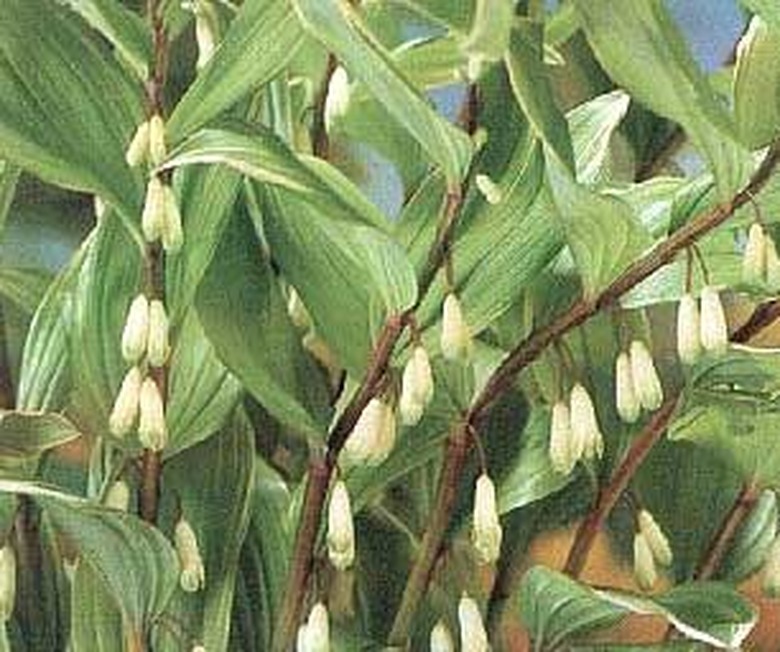Solomons
Step 1
Solomon's seal is lovely ground perennial that thrives in moist and low-light areas, like woodland gardens and near shady walls. Solomon's seal has white tubular flowers that hang off of the plant like bells. Most varieties of Solomon's seal are hardy through USDA zones 3 to 9. If Solomon's seal is grown in a warmer climate, you won't need to prune it except to control its growth. However, if your plant dies back in the winter, pruning Solomon's seal in the spring is necessary.
Step 1
Prune Solomon's seal in the early spring. Remove any mulch or ground cover from the Solomon's seal as soon as the ground thaws out.
- Solomon's seal is lovely ground perennial that thrives in moist and low-light areas, like woodland gardens and near shady walls.
- However, if your plant dies back in the winter, pruning Solomon's seal in the spring is necessary.
Step 2
Remove the dead leaves from Solomon's seal.
Step 3
Cut back the dead vines to 2 or 3 inches above the base of the plant. Remove any diseased vines at the base. Leave any live vines alone.
Step 4
Divide the Solomon's seal at this time if it is crowding itself out.
Step 5
Add compost or manure to the ground around Solomon's seal and work it into the soil to the depth of 2 to 3 inches.
Step 1
Water Solomon's Seal less as fall approaches. Cut back watering to about once a month for 5 minutes each watering until the ground freezes.
- Remove the dead leaves from Solomon's seal.
- Cut back the dead vines to 2 or 3 inches above the base of the plant.
Step 2
Remove any flowers from Solomon's Seal. Leave all other growth alone.
Step 3
Add compost or manure to the soil around Solomon's Seal. Work it into the soil a couple of inches deep.
Step 4
Place 3 to 4 inches of mulch on top of Solomon' s Seal after the first frost.
Shop for Perennial Flower Seeds
Plant InformationType: perennial
Propagation: division and seeds
Light: shade
Flower Color: greenish-white
Height: 1-3 feet (smaller) — 1-6 feet (larger)
Width: 24 inches — spreading habit
Soil Requirements: acid to neutral soil, composted, moist, well-drained
Zones: 5-9
Uses: groundcover, woodland setting
- Remove any flowers from Solomon's Seal.
- Place 3 to 4 inches of mulch on top of Solomon' s Seal after the first frost.
These perennials, native to many areas of North America, are admired for the blue berries that dangle from arching, unbranched stems in the late summer or early fall. The bell-shaped flowers are pale greenish-white and 1/2 to 1 inch long. They are borne in clusters beneath the leaf joints and bloom in the late spring. Small Solomon's seal grows 1 to 3 feet tall and usually bears clusters of one to three flowers, while great Solomon's seal reaches 2 to 6 feet in height and produces up to 10 flowers in each cluster. A lovely plant in any season, the foliage will tint yellow in autumn. Plants are deer resistant.
This plant is well suited to Northeastern Coniferous, Southeastern Coniferous and Deciduous Woodland and the Prairie environments. Provide partial to deep shade and humus-rich soil with a pH of 4.5 to 5.5 for small Solomon's seal and a pH of 5.0 to 7.0 for great Solomon's seal. The larger species, which frequently grows along streams, requires very moist soil, while the smaller does well under drier conditions. Plant rhizomes in spring or fall. They should be 1 to 2 inches deep and 12 inches apart with the tips of the growing shoots just below the surface of the soil. Plants can also be raised from seeds sown in the fall, but they take two to four years to flower. Plants can be divided in the spring. Established plants spread by rhizomes, and also reseed themselves.
- These perennials, native to many areas of North America, are admired for the blue berries that dangle from arching, unbranched stems in the late summer or early fall.
Corydalis
A small, 15-inch high perennial, corydalis (Corydalis lutea) has bluish-green leaves that resemble those of culinary Italian parsley. Its tiny, yellow flowers resemble the flowers of bleeding heart. Corydalis prefers to be planted near rocks in slightly alkaline soil that is well-drained and gravelly. It is an ideal plant for a rock garden or a stone wall. Although it does best in partial shade, corydalis will also grow in full sun. It is a prolific reseeder, although it is difficult to start from seed, due to its complicated stratification requirements, according to the University of Vermont Extension.
False Solomon's Seal
Found in moist woodlands, false Solomon's seal (Smilacina racemosa) grows up to 3-foot long unbranching, arching stems with dark green, alternate leaves. White to yellow flowers appear on a spike which grows out from the terminal end of the stems. Solomon's seal prefers partial to full shade and blooms in late spring.
- A small, 15-inch high perennial, corydalis (Corydalis lutea) has bluish-green leaves that resemble those of culinary Italian parsley.
Ajuga
A fast-growing 3 to 4-inch high evergreen perennial, ajuga (Ajuga reptans) prefers shade to partial shade and sandy, well-drained soil, although it tolerates clay soils. Its glossy, dark, evergreen leaves emerge with a reddish tint before turning green. In spring it produces blue-violet flowers on short spikes. Ajuga works well in moist areas. Because it is so attractive to bumblebees, it is an excellent choice for a bee garden.
